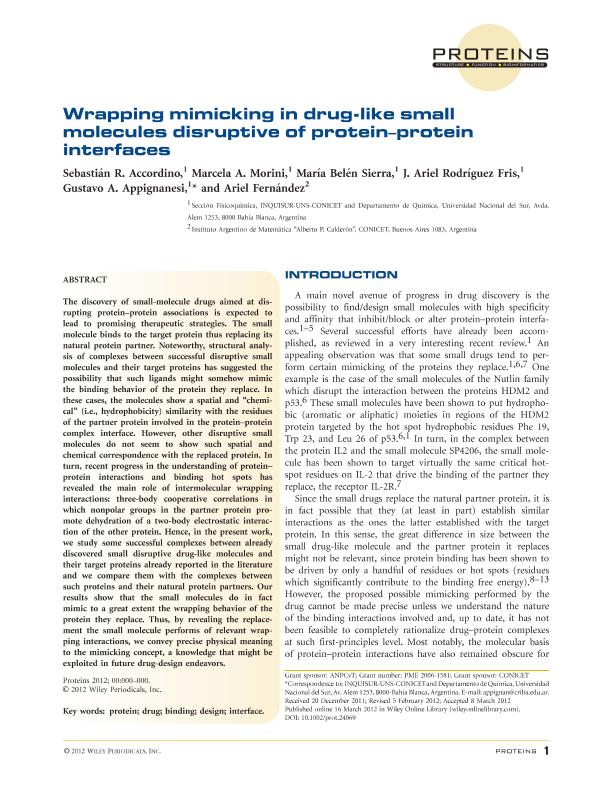Mostrar el registro sencillo del ítem
dc.contributor.author
Accordino, Sebastian Roberto

dc.contributor.author
Morini, Marcela Ana

dc.contributor.author
Sierra, Maria Belen

dc.contributor.author
Rodriguez Fris, Jorge Ariel

dc.contributor.author
Appignanesi, Gustavo Adrian

dc.contributor.author
Fernandez, Ariel

dc.date.available
2018-11-08T18:28:57Z
dc.date.issued
2012-07
dc.identifier.citation
Accordino, Sebastian Roberto; Morini, Marcela Ana; Sierra, Maria Belen; Rodriguez Fris, Jorge Ariel; Appignanesi, Gustavo Adrian; et al.; Wrapping mimicking in drug-like small molecules disruptive of protein-protein interfaces; Wiley-liss, Div John Wiley & Sons Inc; Proteins: Structure, Function And Genetics; 80; 7; 7-2012; 1755-1765
dc.identifier.issn
0887-3585
dc.identifier.uri
http://hdl.handle.net/11336/64004
dc.description.abstract
The discovery of small-molecule drugs aimed at disrupting protein-protein associations is expected to lead to promising therapeutic strategies. The small molecule binds to the target protein thus replacing its natural protein partner. Noteworthy, structural analysis of complexes between successful disruptive small molecules and their target proteins has suggested the possibility that such ligands might somehow mimic the binding behavior of the protein they replace. In these cases, the molecules show a spatial and "chemical" (i.e., hydrophobicity) similarity with the residues of the partner protein involved in the protein-protein complex interface. However, other disruptive small molecules do not seem to show such spatial and chemical correspondence with the replaced protein. In turn, recent progress in the understanding of protein-protein interactions and binding hot spots has revealed the main role of intermolecular wrapping interactions: three-body cooperative correlations in which nonpolar groups in the partner protein promote dehydration of a two-body electrostatic interaction of the other protein. Hence, in the present work, we study some successful complexes between already discovered small disruptive drug-like molecules and their target proteins already reported in the literature and we compare them with the complexes between such proteins and their natural protein partners. Our results show that the small molecules do in fact mimic to a great extent the wrapping behavior of the protein they replace. Thus, by revealing the replacement the small molecule performs of relevant wrapping interactions, we convey precise physical meaning to the mimicking concept, a knowledge that might be exploited in future drug-design endeavors. © 2012 Wiley Periodicals, Inc.
dc.format
application/pdf
dc.language.iso
eng
dc.publisher
Wiley-liss, Div John Wiley & Sons Inc

dc.rights
info:eu-repo/semantics/openAccess
dc.rights.uri
https://creativecommons.org/licenses/by-nc-sa/2.5/ar/
dc.subject
Binding
dc.subject
Design
dc.subject
Drug
dc.subject
Interface
dc.subject
Protein
dc.subject.classification
Otras Ciencias Biológicas

dc.subject.classification
Ciencias Biológicas

dc.subject.classification
CIENCIAS NATURALES Y EXACTAS

dc.title
Wrapping mimicking in drug-like small molecules disruptive of protein-protein interfaces
dc.type
info:eu-repo/semantics/article
dc.type
info:ar-repo/semantics/artículo
dc.type
info:eu-repo/semantics/publishedVersion
dc.date.updated
2018-11-05T19:05:18Z
dc.journal.volume
80
dc.journal.number
7
dc.journal.pagination
1755-1765
dc.journal.pais
Estados Unidos

dc.journal.ciudad
Nueva York
dc.description.fil
Fil: Accordino, Sebastian Roberto. Consejo Nacional de Investigaciones Científicas y Técnicas. Centro Científico Tecnológico Conicet - Bahía Blanca. Instituto de Química del Sur. Universidad Nacional del Sur. Departamento de Química. Instituto de Química del Sur; Argentina
dc.description.fil
Fil: Morini, Marcela Ana. Consejo Nacional de Investigaciones Científicas y Técnicas. Centro Científico Tecnológico Conicet - Bahía Blanca. Instituto de Química del Sur. Universidad Nacional del Sur. Departamento de Química. Instituto de Química del Sur; Argentina
dc.description.fil
Fil: Sierra, Maria Belen. Consejo Nacional de Investigaciones Científicas y Técnicas. Centro Científico Tecnológico Conicet - Bahía Blanca. Instituto de Química del Sur. Universidad Nacional del Sur. Departamento de Química. Instituto de Química del Sur; Argentina
dc.description.fil
Fil: Rodriguez Fris, Jorge Ariel. Consejo Nacional de Investigaciones Científicas y Técnicas. Centro Científico Tecnológico Conicet - Bahía Blanca. Instituto de Química del Sur. Universidad Nacional del Sur. Departamento de Química. Instituto de Química del Sur; Argentina
dc.description.fil
Fil: Appignanesi, Gustavo Adrian. Consejo Nacional de Investigaciones Científicas y Técnicas. Centro Científico Tecnológico Conicet - Bahía Blanca. Instituto de Química del Sur. Universidad Nacional del Sur. Departamento de Química. Instituto de Química del Sur; Argentina
dc.description.fil
Fil: Fernandez, Ariel. Consejo Nacional de Investigaciones Científicas y Técnicas. Oficina de Coordinación Administrativa Saavedra 15. Instituto Argentino de Matemática Alberto Calderón; Argentina
dc.journal.title
Proteins: Structure, Function And Genetics

dc.relation.alternativeid
info:eu-repo/semantics/altIdentifier/doi/https://dx.doi.org/10.1002/prot.24069
dc.relation.alternativeid
info:eu-repo/semantics/altIdentifier/url/https://onlinelibrary.wiley.com/doi/abs/10.1002/prot.24069
Archivos asociados
